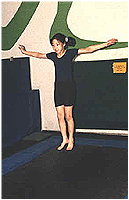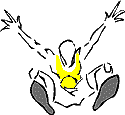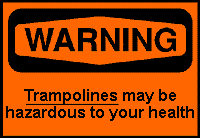 | Jumping is Nice, But Think Twice |  |
 | Jumping is Nice, But Think Twice |  |
|
By Ellen Kuwana Neuroscience for Kids Staff Writer June 11, 1999 |
 |
Sproing! Sproing! Sproing! |
 |
 Jumping on a trampoline is one of the few ways to feel
weightless on Earth, but statistics show that trampoline accidents are the
cause of many neck and spinal cord injuries. Trampoline purchases have
been increasing over the years, and with trampoline events being featured
for the first time in the 2000 Olympics, more children than ever will be
exposed to trampolines. Let's take a closer look at how risky this
apparatus can be. Jumping on a trampoline is one of the few ways to feel
weightless on Earth, but statistics show that trampoline accidents are the
cause of many neck and spinal cord injuries. Trampoline purchases have
been increasing over the years, and with trampoline events being featured
for the first time in the 2000 Olympics, more children than ever will be
exposed to trampolines. Let's take a closer look at how risky this
apparatus can be.
|
 The American Academy of Pediatrics in May 1999 issued a policy statement
with the following recommendations:
The American Academy of Pediatrics in May 1999 issued a policy statement
with the following recommendations:
September, 2012, POLICY STATEMENT from the American Academy of Pediatrics: Trampoline Safety in Childhood and Adolescence |
|
[*Note from Eric H. Chudler, Ph.D.: The
author of this "In the News" story, Ellen Kuwana, was a competitive
gymnast in high school and has been a gymnastics coach for nearly 20
years. She has extensive experience using the trampoline and would like
to share a few thoughts about the warnings about trampoline use.]
"Yes, trampolines can be very dangerous. Generally speaking, I think it is wise to prohibit trampoline use at school and at home. The risk of injury is just too high. Most often children use trampolines unsupervised, or attempt skills beyond their abilities. I was surprised to discover that private use in people's own backyards has increased. This is perhaps why the number of trampoline-related injuries has climbed steadily in the past decade. |
 |
| BACK TO: | Neuroscience in the News | Table of Contents |
![[email]](./gif/menue.gif) Send E-mail |
![[newsletter]](./gif/menunew.gif) Get Newsletter |
![[search]](./gif/menusea.gif) Search Pages |